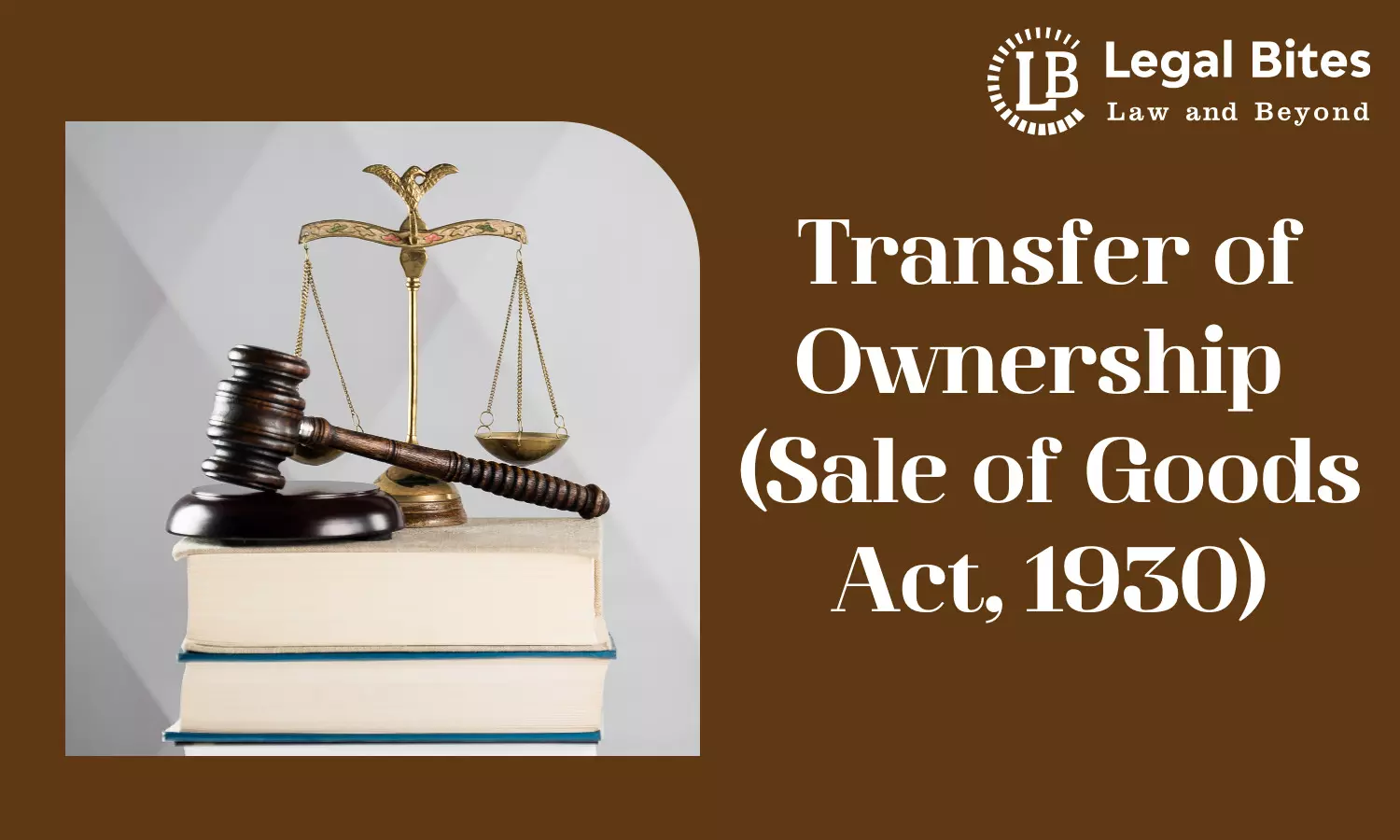Transfer of Ownership | Sale of Goods Act, 1930
The article 'Transfer of Ownership under the Indian Sale of Goods Act, 1930' delineates the regulations governing the transfer of property through contractual agreements.

The article 'Transfer of Ownership under the Indian Sale of Goods Act, 1930' delineates the regulations governing the transfer of property through contractual agreements involving the sale of goods. The fundamental provisions encompass the transfer of property at a designated time, the condition of specified goods being in a deliverable state, and the handling of unascertained goods. Additionally, the Act incorporates provisions for exceptions that pertain to individuals who are not...
The article 'Transfer of Ownership under the Indian Sale of Goods Act, 1930' delineates the regulations governing the transfer of property through contractual agreements involving the sale of goods. The fundamental provisions encompass the transfer of property at a designated time, the condition of specified goods being in a deliverable state, and the handling of unascertained goods. Additionally, the Act incorporates provisions for exceptions that pertain to individuals who are not the rightful owners, including scenarios involving joint owners or transactions conducted by mercantile agents.
Introduction
Indian Sale of Goods Act, 1930 provides a thorough legal framework that regulates ownership in the context of commercial transactions in India. This important part of the legislation creates a series of guidelines that precisely explain the particulars of ownership transfer in the sale of goods. The Act outlines the circumstances under which ownership is transferred, protecting the rights and interests of both sellers and buyers and guaranteeing fairness and justice in the trade of assets. The Act is important in promoting smooth business transactions and a safe and dependable business environment in the Indian market, since it defines the essential elements of ownership transfer, like the precise time, mode of transfer, and conditions in which it takes place.
Transfer of Ownership
Existing goods (Section 6) that are present during the time of the contract are divided into two types:
- Specific/ Ascertained Goods (Section 2(14)): Specific goods are precisely recognised and determined by the buyer, and what he wants to purchase during the preparation of the contract. Ascertained goods are not defined but these goods are associated with specific goods. On the other hand, are precisely chosen from a broad range of items.
- Unascertained Goods: Unascertained goods are not precisely identified when the sale of the contract is being formed.
Future Goods [Section 2(6)] are those that will either be manufactured, produced, or acquired by the buyer at the time the contract is formed. In the future, when products are sold there won’t be a physical sale only an agreement to sell.
Contingent Goods implies to those goods that are subject to some condition before the sale is finished
Thus, the steps to transfer ownership are:
Property passes when intended to pass (Section 19) :
This section discusses the situation where a contract already exists for the sale of particular or specified goods, and the buyer becomes the owner of those items at the time specified by the contractual parties.
- To ascertain the parties' intents, the terms of the contract, the behaviour of the parties, and the specifics of the case have to be considered.
- Unless the parties specifically state otherwise, the guidelines provided in the Act's provisions are intended to ascertain their intentions by the transfer of ownership of the commodities.
Specific Goods: When a contract is in place for the sale of certain items and the seller is required to make a change to the items to make them deliverable, the property does not transfer until that change is made and the buyer is informed of it.
Specific goods to be put into a deliverable state (Section 21): The goods do transfer until the seller completes the task and notifies the buyer of it if there is a contract for the sale of specified goods where the seller is required to make certain changes to the items to make them deliverable.
Sale of unascertained goods and appropriation (Section 23):
- When products that meet specifications and are in a deliverable state are used in a contract, either by the seller with approval from the buyer or by the buyer with approval from the seller.
- The buyer acquires complete ownership of the commodities upon execution of the contract for the sale of goods, whether they be future products or undetermined goods by description. This consent may be provided either expressly or implicitly, and it may take place before or following the transaction.
- The seller is said to have unconditionally appropriated the products to the contract if he does not reserve the right of disposal and provides the goods to the buyer, a carrier, or another bailee in line with the conditions of the agreement for transmission to the buyer.
Seller or buyer in possession after sale[Section 30(1)]: The person who sold the goods continues to own the goods or the documents related to the goods, or if a mercantile agent acting on his behalf delivers or transfers the goods or the documents about any sale, pledge, or other disposition of the goods to any person who receives them in good faith and without being notified of the previous transaction, the effect will be the same as if the person delivering or transferring had the owner of the goods’ express consent to make the transfer.
Case Laws
The State Trading Corporation of India Ltd. vs. M/s Tini Pharma Pvt. Ltd (2011):
In this instance, the buyer bought 1820 kg of material that might have been imported at a weight of 2980 kg, and the corporation is a governmental organisation. The petitioner assigned 975 kg to the respondent, but the shipment was delayed. As a result, the government raised the material's price. The petitioner's attempt to charge higher charges by the Indian government letter was denied by the court. The respondent was not obligated to pay the increased price, since the court determined that the letter could not be applied retroactively and that ownership of the goods had already passed during the time the full amount was paid.
Badri Prasad vs. State of Madhya Pradesh (1965):
There was an agreement between the parties about the specific forest of Madhya Pradesh. Teak trees with girths more than 12 inches could only be chopped by the appellants. Then appellant could not cut trees to exercise his rights under the contract after an Act was passed. Thus, it was held that the forest and trees are the State’s property, and the appellant has no right to chop down the teak trees with girths greater than 12 inches. But under that description, it needed to be mentioned about the fallen trees. They won’t be considered ascertained commodities under the Sale of Goods Act until it is determined.
Conclusion
Indian Sale of Goods Act,1930 plays a pivotal role in governing the transfer of ownership within commercial transactions in India. Its meticulous guidelines ensure the protection of both sellers' and buyers' rights, fostering a secure and equitable business environment. Through its defined rules on existing, future, and contingent goods, the Act facilitates clear protocols for ownership transfer, considering factors such as specific goods, goods to be put in a deliverable state, and unascertained goods. This comprehensive legal framework is instrumental in promoting transparency and reliability, thus contributing significantly to the smooth functioning of the Indian market.
Reference
[1] The Sale of Goods Act, 1930, Available Here
Important Links

Shruti Roy
Shruti is a student of Symbiosis Law School, Noida. As a young and aspiring legal enthusiast, she finds herself captivated by the intricate world of corporate law.
